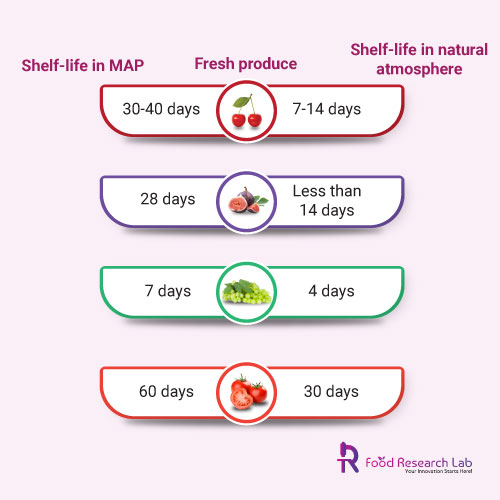
Increasing Fruit And Vegetable Shelf Life
Product Developments For Extending The Shelf Life Of Fruits And Vegetables
There’s nothing worse than having your fresh fruit expire too soon as a producer or supplier. This may harm your reputation and be costly to resolve. Not to mention the hundreds of millions of tonnes of food wasted and lost each year throughout the world. Growers and exporters enhance the shelf life of their fruits and vegetables to give them the best chance of staying fresh.
Packaging Improvements And Modified-Atmosphere Packaging (MAP)
Improving packaging is a simple way to increase the shelf life of fruits and vegetables. Packaging that extends the shelf life for food products can regulate the rate of respiration, ripening, and microbiological development. Extended seasonality, reduced food waste, and a better possibility of keeping freshness are advantages of longer shelf life.
The gases surrounding an object are controlled using modified atmosphere packaging (MAP). Limiting the amount of oxygen that surrounds fruit, for example, can extend its shelf life. Pallet coverings, carton containers, and sheets can all aid with ethylene control.
Procedures For Treatment And Handling Are Being Improved.
You must ensure that your treatments and handling procedures do not damage fruit or vegetable when picked. Using polluted water to clean products or putting them in contaminated crates are examples of inadequate treatment practices. Furthermore, ensuring that fresh produce is not subjected to high pressures would prevent damage, and even slight issues might shorten the shelf life. Following standard operating procedures (SOPs) is critical to guarantee correct handling.
Identifying Cold Chain Temperature Weaknesses
Maintaining a low temperature helps to prevent deterioration and microbial development. The products can be harmed if any portion of the cold chain between harvest and buyer is disrupted. According to one research, waiting four hours between harvest and precooling strawberries increased water loss by over 50%. It also detracted from the look when the package arrived at the distribution site. There are a few ways for recording temperature across the cold chain that are useful. This information can also be used to forecast shelf life.
Monitoring Humidity To Find Areas For Improvement
Temperature tracking isn’t the only thing to keep track of. The two are frequently combined as well. High humidity aids in the preservation of moisture in fruits and vegetables. Refrigeration can cause humidity loss; thus, maintaining correct humidity levels is essential for shrink prevention. IoT sensors monitor the temperature and humidity of products as they travel from the farm to the client, allowing for identifying areas for improvement.
Food Trays And Pads With Absorbents
Food packaging and shelf life go hand in hand. Pads that can go in the containers of fresh-cut vegetables have seen a lot of experimentation. Pads absorb extra fluids and can aid to reduce the rate at which a product breathes. Although they are currently widely utilized in the business, it’s essential to stay current with the growing capabilities of absorbent pads.
Antimicrobials From Nature
Antimicrobials like herbs, spices, and plant extracts can prevent spoiling and improve shelf life. It’s critical to look for natural chemical alternatives as buyers want safer components, and food manufacturers can utilize it as a selling element to attract more clients.
Changing Varieties
Since the dawn of agriculture, people have been looking for innovative methods to create better-tasting varietals. Produce types with longer shelf lives are a focus now that our planet is increasingly spread out, and we ship across the globe. The USDA, for example, just released a strawberry with a longer shelf life. After a week in cold storage, just 29% of the strawberries decayed, compared to 93% of Camarosa strawberries. If you’re open to trying new types, it’s a good idea to keep an eye on what’s available and weigh your options.

Coverings For Individual Items
Fresh vegetables with natural, plant-based coverings have recently gotten much attention. Apeel, for example, has collected several hundred million dollars for their answer. Produce deteriorates due to water loss and oxidation (a chemical process requiring oxygen). A peel’s covers keep moisture within while allowing oxygen to escape.
What Immediate Advantages Would You Gain If You Could Increase The Shelf Life Of Your Produce By Days Or Even Weeks?
An answer is most likely a large number. You may accept more shipments, have less shrink and loss, and increase your profit margins. Long-distance exports become possible, and you can ensure higher-quality fruits and vegetables. Healthy vegetarian products consultants can help you with this regard.
Conclusion
Reduced fresh produce food loss and waste lowers costs, enhances brand reputation, and aids in achieving sustainability objectives. Shelflife testing is highly crucial in today’s food processing segment. There are numerous techniques to lengthen shelf life, and the optimum approach depends on the application. Another practical approach for decreasing food loss and waste is shelf life prediction, which does not involve physical product modifications.






